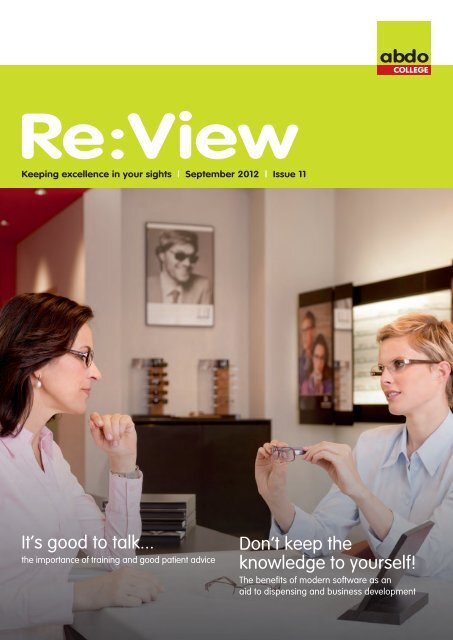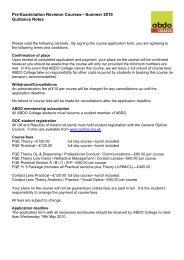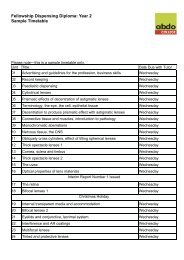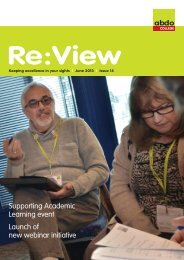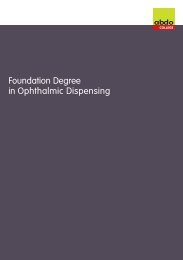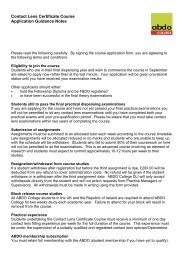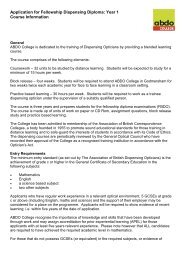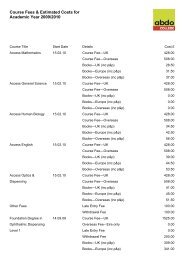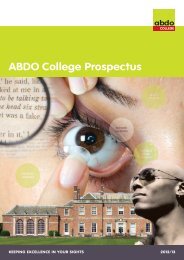ReView September 2012 - ABDO College
ReView September 2012 - ABDO College
ReView September 2012 - ABDO College
- No tags were found...
You also want an ePaper? Increase the reach of your titles
YUMPU automatically turns print PDFs into web optimized ePapers that Google loves.
It’s good to talk...Rodenstock’s Ian Harrison outlines the importance of training and good patient advice“Do you get on all right with your existing varifocals Mrs Smith? Yes?Ok, we’ll do the same again with your new prescription.“Since you last had your varifocals Mrs Smith, there have been somedevelopments in spectacle lens designs – let me tell you about themand then you’ll be well informed to make a decision about your newlenses.”Be honest, it’s a busy clinic and you have a couple of adjustmentswaiting, as well as the collection by the ‘myopic engineer’ – what isthe most likely conversation you’ll have with Mrs Smith, who’s justpresented with an 0.50D increase in her Add?“But, I’m too busy!”The difference between purchasingglasses online or being dispensedspectacles in your practice is just yourexpertise and time... We are all familiarwith the average price of a pair ofspectacles being higher on quieter days,simply because we have the time to sitand talk to our patients. Make time totalk; reorganise clinic days, delegatenon DO tasks, extend the skills of yoursupport staff, anything and everythingto allow you to spend more time in frontof your patients, doing what you trainedand qualified to do.More and more consumers areresearching a product online before theygo anywhere near a shop or practice.73 per cent of the population wearingspectacles are between 45-59 years oldand 93 per cent are 60+ years old*.They are increasingly computer literateand have the time to research theinternet and high street to shop around,not just for the best price, but also forthe best product.Where do you prefer to shop? Is itthe ‘Out of town giant’ or the ‘Neverknowingly undersold’ store? Personally,I prefer to possibly spend a little moretime and money and be advised bysomeone who knows the productinside out, rather than someone whoknows less than I do, but can ‘check ifit’s in stock’.As a lens manufacturer, we havenoticed a massive increase in thenumber of consumers contacting usdirect, wanting to know about ourproducts. We happily forward themto their nearest stockist to continue theconsultation; however it demonstrateshow the market is changing. Asdispensing opticians we need to atthe very least keep up and at best,stay ahead. The very minimum ourpatients/customers should expect isthat we will offer them the very bestadvice about spectacles, whether that’sregarding frame designs, fittings andmaterials or lens types and materials,enabling them to make an informedchoice. If we don’t talk about the featuresand benefits of all our products, wecan’t be disappointed when ourcompetitors do.When I entered optics 30+ yearsago, it was an exciting time as varifocalshad just arrived... otherwise we hadvery limited opportunity to talk abouttechnology - high index glass, asphericlenses and D seg bifocals were the limitsto our upgrade portfolio. We are spoiltfor choice now and although it’s achallenging time for optics and retail ingeneral, it couldn’t be a more excitingtime to be a DO!How often have you discussedvocational lenses or individualised lensesthis week and do you remember howto measure Face Form Angle, CornealVertex Distance, and Pantoscopic Tilt,etc.; or are these not necessary foryou because OC’s and heights are allyou need?A recent survey** demonstrated that24 per cent of practices had no product,sales or customer service training in atypical year, whilst 20 per only had anytype of training once in a year. How isit possible to keep a practice at the*Source: Strategy with Vision**Sponsored by Optix Software3
cutting edge of technology (and aheadof the competition) without any producttraining? All spectacle lens suppliersare only too willing to arrange trainingdays for professional and support staff,at times to suit the business and it’s freeof charge. Embrace any training availablefor your practice staff and be amazedat what is available to you to talk aboutto your patients. Either that, or wait foryour customers to come in and tell youabout the new developments.My sister and her husband recentlyhad their eyes tested at their localindependent practice. They both hadreached the dreaded presbyopic stageand surprisingly they were bothrecommended two separate pairs –‘a pair for distance and a pair forreading’... in <strong>2012</strong>! Fortunately, I amin a position to make their spectaclesfor them and although they boughtseparate pairs, it was one pair ofclear varifocals, one pair of varifocalsunglasses and a pair of vocationalnear vision specs for PC use each.Did the DO think he was doing thema service by saving them the costof varifocals? Or did he think theywouldn’t tolerate them?We shouldn’t be embarrassed abouttalking about the best and thereforemost expensive frame or lens options,as long as we can talk about thebenefits with confidence and can offeralternative options. One pair ofspectacles can very rarely provide theoptimum for all day, every day, anymorethan just one pair of shoes. I personallyhave a few pairs of varifocals (differentframe styles for different occasions),a couple of pairs of computer specs(one at home and one at the office),a pair of half eyes by the bed anda couple of pairs of sunglasses (onesporty and one fashionable) and Idon’t even like wearing specs!The only person who can make adecision on their eyewear is your patientor customer. They may not take yourrecommendation today, however, thenext time they are looking down theirnose and struggling to see the fullwidth of the computer screen, they’llpossibly remember your advice abouta complementary pair of computerspecs and be back, but only if youtalked to them...Ian Harrison FBDO is National SalesManager for Rodenstock UKRodenstock is sponsor of The RodenstockTechnology Library at <strong>ABDO</strong> <strong>College</strong>4
EDUCATIONAL SUPPLEMENTabdoCOLLEGEBifocals (part 1)by Sally Bates BSc (Hons) FBDO Cert Ed, <strong>ABDO</strong> <strong>College</strong> LecturerThe topic of bifocals is a fundamental part of the <strong>ABDO</strong> FQE theory and practical examination syllabus.Assessment of this topic includes the discussion of bifocal dispensing solutions and suitability, lens availability,‘jump’ and dealing with non-tolerances. FQE examination candidates are also required to submit fourelementary bifocal case records as part of their pre-qualification portfolio (PQP); dispense a high poweredpair of bifocals and, using a focimeter, verify a basic pair of bifocals against a written order.Bifocal lenses may be considered as a little old fashioned in today’s world, as the majority of first timepresbyopes are encouraged to wear progressive lenses or select single vision distance and readingspectacles. However there are still many existing bifocal wearers who do not wish to change their lensdesign, so bifocals remain important to ensure patient satisfaction.Bifocal lenses are frequently an essential dispensing option; for example when inducing prism for nearvision tasks only, or when dispensing a prescribed reading addition to children, also in the case of correctingdifferential prismatic effect due to anisometropia, or for vocational or occupational use.Lens selectionThe following points should be considered when dispensing bifocals:• Both lens portions should provide equal clarity for distance and nearvision; ‘jump’ should be minimised (the definition and calculation of‘jump’ will be covered in part 2 of this article, to be published in thenext issue of Re:View ).• There should be minimum differential prism between the two eyesat the NVP (near visual point) ensuring no diplopia when reading.• The segments should be as inconspicuous as possible to maximisethe cosmetic success.Choice of segmentThe patient’s individual needs and requirements must always be identified:• Ask ‘open’ questions to enquire about the patient’s occupation, hobbiesand lifestyle. This will enable you to determine the best lens type, segmentsize and segment top position for your recommendation to the patient.• If available, check the previous pair of bifocals: segment shape,segment size, lens material, manufacture of glass segments (fused orsolid), segment top position in relation to the lower limbus and find outif the patient has encountered any difficulties with their previous pair.• Check the patient’s posture when standing and sitting. If the patientis very tall, consider reducing the segment heights by approximately2mm as the patient constantly looks downwards. If the patient suffersfrom osteoporosis consider setting the segments approximately 2mmhigher than lower limbus, to ease the patient’s near vision tasks.The segment shape and size shouldbe determined by:• The patient’s prescriptionIdeally straight/flat top, ‘S’/‘D’, segments should be dispensed tomyopes as they induce less ‘jump’. Ideally round segments should bedispensed to hypermetropes as they induce less prismatic effect at near.• The patient’s occupationConsider the patient’s distance and near vision requirements. Forexample, if the patient’s work involves mainly near vision, the dispensingoptician could recommend a large segment, possibly set higher thanthe lower limbus. If the patient’s work involves plenty of driving, the DOcould recommend a small segment, possibly set lower than normal.If the patient’s work involves excessive computer use, a bifocalcombination of intermediate vision and a large segment for near vision,probably set higher than the lower limbus, could be recommended.• The patient’s hobbiesThe working distance is necessary as it is a vital element of dispensing,the correct near addition for the patient’s specific tasks is essential.The most suitable segment size and top position must be consideredfor the patient to successfully perform their hobbies.• Any previous bifocal spectacles?If the patient has previously worn bifocals, confirm the lens material,segment shape, size and position in relation to the lower limbus.Also assess the existing frame fitting, the bow of the frame front (faceform/dihedral angle), pantoscopic tilt and lens depth.
Flat top segments• Ideal for minus powered prescriptions as they induce lessprismatic ‘jump’• Suitable for plus powered prescriptions up to approximately +3.00D• The optical centre of the segment is approximately 2mm below thedividing line• Available segment diameters: 25, 28, 35, 40 and 45mm (figure 1)• ‘Jump’ is reduced when looking through the segment• Available in hi-index 1.67AS clear and Transitions, 1.6AS, 1.5 plastics• Available in Trivex, S28 clear and Transitions, S35 clear and TransitionsGrey only• Available in polycarbonate S28 and S35• Available in hi-index fused glass D28 1.8figure 2Curved top segments• Ideal for plus and minus prescriptions as they induce less ‘jump’• The optical centre of the segment is approximately 2mm below thedividing line• Available segment diameters: 25, 28, 35, 40mm (figure 3)• Less light is reflected from the segment top• Cosmetically more appealing than flat top segments• Available in hi-index 1.74 AS, 1.67AS, 1.6AS, 1.5 plastics• C28 available in Transitionsfigure 1Round segments• Ideal for plus prescriptions over approximately +3.00D as the prismaticeffect is reduced when looking through the segment, this is due to thebase down prism produced by the segment• Larger diameter round segments induce more base down prismat near• Available segment diameters: 22, 24, 25, 28, 30, 38, 40, 45mm(figure 2)• Round 24mm is available in Trivex, clear and Transitions Grey only• 30mm solid segment available in 1.7 glass• High addition availability: 22mm segment is available up to +20.00Daddition; 28mm segment is available up to +15.00D additionfigure 3
Sally Bates BSc (Hons) FBDO Cert EdSally Bates is the proprietor of Identity Optical Training, specialising in training courses for practical examination revision and opticalassistants Level 2 and 3 training. She is also an <strong>ABDO</strong> examiner and part-time lecturer at <strong>ABDO</strong> <strong>College</strong>, where she is responsible forteaching all aspects of practical ophthalmic dispensing.E-line segments• Ideal for minus powered prescriptions as they are ‘no jump’• The optical centre of the segment is placed on the dividing line• Cosmetically unappealing, the near portion edge is thin and tendsto chip easily• Referred to as E-line or E-type, formerly known as Executive (figure 4)• Available in 1.5 plasticsFusedCR39figure 5figure 4Segment manufacturePlastics segments are moulded – the segment can be felt on the frontsurface of the lens (figure 5).Glass segments are either solid or fused:• Solid segments – the dividing line can be felt on either the front orback surfaces.• Fused segments – the dividing line cannot be felt on either surfaceas the segment is manufactured from a higher index than the maindistance portion of the lens. The segment is heated and placed intothe lens depression curve. The segment fuses due to the differencein refractive indices, with the segment being of a higher index.Obviously this method of production cannot be used with plasticlens materials.Pre-adjust the spectacle frame priorto taking measurements• Check the frame fitting on the bridge of the nose, adjust the distancebetween pad centres if necessary• The pantoscopic tilt should ideally be 8–10º• All aspheric and hi-index bifocals should be fitted at a 10º tilt as thisenables easier reading facilitating a natural angle of gaze fromdistance to near vision• Check the temple width and head width – an incorrect fitting will causethe segments to sit too low• Check the side length to bend and fitting – if the spectacles slip forwards,the segments will be positioned too low for readingAlways ask if the patient was satisfied with their existing bifocals• Confirm the lens material, segment shape, size and position in relationto the lower limbus• Assess the current frame fitting, the bow of the frame front (face form/dihedral angle), angle of side and lens depth• If any of these factors are changed, it may result in a dispensingnon-toleranceSpecifications required• Distance PD and near PD – in order to calculate the accurate inset• Segment shape• Segment size• Segment top position• Lens material
EDUCATIONAL SUPPLEMENTSegment top position• Flat top and curved top segments should be dispensed approximately1–2mm below the lower limbus (figure 6)2mmfigure 6figure 7• Round segments should be dispensed approx 1mm above the lowerlimbus (figure 7)• This enables easier reading as the optical centre of the segment isfurther below the segment top• The minimum fitting height is ideally 13mm or more• If the patient is a child requiring bifocals, the segment top shouldideally be positioned midway between the pupil centre and thelower limbus to enforce use• In the case of a patient suffering from ectropian, the segments shouldbe positioned at the lower limbus and not the lower eyelidSegment inset• Each segment is generally inset 2–2.5mm, as each eye convergesapproximately 1–3mm for near vision• Plastics bifocals maybe specially manufactured to correct inset byany amount required to match the patient’s convergence• The accurate inset for each eye is calculated by:Inset = Mono Distance CD – Mono Near CD• Base in prism for near vision only maybe induced by increasingthe inset of a large D segment. The decentration of the segment iscalculated using Prentice’s rule:PInset = –––––––F AddAdvice to wearersTo prevent neck strain and headaches, advise the patient to practicelooking down through the lenses when they are reading. If the patientstarts to tilt their head and neck backwards to see, they will develop abad habit that will turn into a real pain in the neck!When going down steps and stairs, remind the patient to keep theirchin in, and look through the top of the lens to see their feet. Adaptionto the small field of view offered by the bifocal segment can often takesome time as the wearer learns to move either, their head or the readingmaterial, rather than their eyes.If the patient uses a computer, the monitor is generally placed directlyin front of the user and can lead to muscle fatigue due to the unusualstraight and constant movement of the head.This article features only a selection of bifocal lens availability, for thefull extensive range of all lenses please refer to ‘Ophthalmic LensesAvailability ’ available from the <strong>ABDO</strong> <strong>College</strong> Bookshop, or the latestmanufacturers’ lens catalogues.ReferencesThe Norville Prescription CompanionOphthalmic Lenses AvailabilityPractical Dispensing by Anthony I GriffithsPractical Optical Dispensing by David WilsonPublished as a supplement to Re:View, the <strong>ABDO</strong> <strong>College</strong> newsletter, <strong>September</strong> <strong>2012</strong>, Issue 11 | <strong>ABDO</strong> <strong>College</strong>, Godmersham Park, Godmersham, Canterbury, Kent CT4 7DT
abdoCOLLEGEA unique career opportunityin dispensing opticsWorking in partnership, <strong>ABDO</strong> <strong>College</strong> andCanterbury Christ Church University are proudto offer a comprehensive blended learningcourse for prospective dispensing opticians:• The only blended learning degree course inophthalmic dispensing available in the UK• Leads to a BSc (Hons) degree and theregisterable FBDO qualification• A successful partnership committed to thefurtherance of dispensing optics• Equips students with the ability to problemsolvewithin the practice, benefiting bothstudents and their employers• A proven track record of success throughconsistently high theory and practicalexamination results• Establishes a platform to build furthercareer advancementFoundation Degree/BSc (Hons)in Ophthalmic DispensingA two year Foundation Degree course followed by a third year BSc Degreecourse in Ophthalmic Dispensing – leading to BSc (Hons) and the <strong>ABDO</strong>Level 6 FBDO qualifications.Course features• Combines academic and work-basedlearning• 32 weekly distance learning units in eachacademic year• Four weeks block release at Godmershamin each academic year• Access to supplementary web-basedinteractive tutorial presentations• Block release accommodation can beprovided• Year 1 courses will commence in<strong>September</strong> <strong>2012</strong>Entry requirements• Grade C or above GCSE in English,mathematics, science and two othersubjects, including evidence of recentlearning• Applicants must be working in practiceas a trainee dispensing optician for aminimum of 30 hours per week and havethe support of their employerKEEPING EXCELLENCEIN YOUR SIGHTSFor further information and applicationforms for this and other courses, or torequest a copy of the <strong>2012</strong>/13 <strong>ABDO</strong> <strong>College</strong>Prospectus, please contact the <strong>ABDO</strong><strong>College</strong> Courses Team on01227 733 911or email info@abdocollege.org.uk<strong>ABDO</strong> <strong>College</strong> Operational Services,Godmersham Park, Godmersham,Canterbury, Kent CT4 7DTwww.abdocollege.org.ukwww.twitter.com/abdocollege5
Master of Artsfor MichelleDon’t keep the knowledge to yourselfPhilip Mullins discusses the benefits of modern software<strong>ABDO</strong> <strong>College</strong>is delightedto announcethat its headof operationalservices,MichelleDerbyshire,has attaineda Master ofArts (MA) in Management Studies fromthe Business School, Canterbury ChristChurch University.Her research was based on a qualitativeexploratory case study investigatingthe effective communicating of strategicchange in volunteer organisations.Business communication has a centralrole in the management of change forboth commercial and not-for-profitorganisations and although volunteersare recognised as a vital resource formany voluntary organisations there hasstill been little discussion of the distinctneeds for communicating strategic changewith volunteers. Michelle’s research wenta small way to help address that gap.Commenting on her researchMichelle said “I have been a volunteermanagement consultant at Vision AidOverseas since March 2011, they werethe subject of the ‘case study’ and mythesis is being used to strengthenbusiness communication at Vision AidOverseas. I would especially like tothank all the Board, staff and volunteerswho took part in my research for theirwilling cooperation and candid responses.I have learnt so much!”Although the internet companies havebeen around for some years now, thetotal optical sales via e commerce remainrelatively small, but continue to growand be a thorn in the side of high streetopticians, both independent and multiple.So how do we ensure that the growthis kept to a minimum and our patientscontinue to visit our practices yearafter year?Obviously there is no one answer, butone of the biggest issues is knowledgeand I don’t mean optician knowledge,I mean patient knowledge. One of theinternet’s main attractions is they pursued‘customers’, that all bits of plastic arethe same and that little knowledge isrequired to select glasses. So a customercan select from an online catalogue,decide on all the options and pay, withlittle or no interaction from the seller tothe buyer. But we all know this is notthe case, everything is not the same,and there is a massive differencebetween uncoated CR39 and a 1.74bi-aspheric with multi coat and moreimportantly a massive difference inbenefits. So why do our patients becomeinternet customers? I would suggestits knowledge! As an industry we havebeen guilty in allowing price to becomean overriding factor and as a result thepublic are willing to pay £100 an hourto have their car serviced, yet moan atpaying £25 to have an eye examination,will pay £3 for a cup of coffee and weworry about offering the latest contactlenses at £1.50 per day. Is it not timeto educate our patients and show themthat you only get one set of eyes andthey should not be just entrusted to thelowest price offering?As a company, the National EyecareGroup has spent the last twelve monthslooking at ways to support ourmembers, in the endeavour to educatetheir patients and importantly potentialpatients. We looked at three keyareas, firstly the process required tocommunicate to patients, secondlyhow to engage with patients and finallyhow to educate patients in the practice.All practices have a patient database of some sort, be that a cabinetfull of paper records or the latest upto date management software. Thisdata is then used to send recalls topatients to bring them back to thepractice, usually when it is time for afurther examination. So our IT divisionOptinet, took the activity of sendingrecalls, broke it down in to little bitsand then reconstructed it. The two bigissues were cost and dead data, bothneeded resolving to ensure practicemaximised the potential held withintheir existing data base.The cost issue can be resolved intwo main ways, firstly by enablingcommunications to be sent in fourdifferent ways, telephone, text, emailor letter, enabling a choice of the bestway to speak with each patient andtherefore maximise the response whileminimising the costs. To further reducethe costs a central mailing system canbe utilised, which allows practices toprint, pack and post a letter or post6
!as an aid to dispensing and business developmentOfficial <strong>ABDO</strong><strong>College</strong> sponsorscard for less than the cost of the stamp,so saving massively on time and money.The next issue is the data itself,although many practice have massivedatabases, it is surprising howinaccurate they are. Often the addressesare wrong, no post codes, speltincorrect, missing town information etc.,but also have patients who have diedor moved away. So it’s important tohave ‘data washing’, as the namesuggests it cleans a practice’s data,ensuring the address are correct,removing people who have moved away,ensuring that the letters you send getto the people they are intended for.So we have the process in place,now we need to look at how to engagepeople and draw them into the practice.Practices need to be able to tap in tothe very latest marketing materials,including web pages, posters, leafletsand mailings. It’s important for apractice to promote the right messagefor their business and more importantlyit’s not all BOGOF (Buy One Get OneFree) or high discounts, it’s all aboutpromoting quality, service, educatingand so on. Ideally you need to builda marketing portfolio that will engageboth existing patients and potentialnew ones, encouraging them to visit thepractice time and time again, withoutthem feeling pressurised or ‘sold to’,enabling them to make informedchoice, building loyalty and profitability.Finally, once you have the patientsin the practice, you need to give themthe knowledge to make the choice,breaking them away from the “well it’sjust bits of plastic” and the “I just needa quick test so I can replace my specs”and this is where software comes in.By using the very latest animationtechniques, images, slides and videos,modern software solutions nowenable you to show your patients yourmessage, explain complex clinicalissues, enhance the dispensingprocess and differentiate your practicefrom the competition. Available on thepractice website, in the waiting room,the consulting room or on an iPad,you can use these software tools inall areas of your business, ensuringa consistency of your information.Gone are the days of all the little bitsof paper with a scribbled drawing,gone are all the lengthy explanationsabout what is a cataract, or glaucoma,in its place are modern, effectivecommunication platforms to aiddispensing and business development.The overall message is thateducated patients are more loyal,make better choices and are moreprofitable to the business, so as aprofession we should embrace theconcepts and build them into ourbusiness, or we’ll have ourselves toblame when our patients leave usfor the internet and that bit of plastic.Philip M Mullins FBDO is Directorof Business Development for PKNational Eyecare GroupOptinet is sponsor of The DispensingTechnology Suite at <strong>ABDO</strong> <strong>College</strong>The <strong>ABDO</strong> <strong>College</strong> Board of Trusteesand staff would like to thank its officialsponsors for their generous andcontinued support:BiB Ophthalmic InstrumentsBierleyCarl Zeiss Vision UK LtdCerium Group LtdEssilor LtdNorvilleOptinet LimitedRodenstock (UK) LtdSignet Armorlite EuropeTransitions OpticalThe Worshipful Companyof Spectacle MakersYounger OpticsFor further information on <strong>ABDO</strong> <strong>College</strong>sponsorship opportunities contactMichael R Potter FBDO on 01227 733 913or email at mpotter@abdo.org.uk.7
abdoCOLLEGEBOOKSHOP<strong>ABDO</strong> <strong>College</strong> BookshopMake the <strong>ABDO</strong> <strong>College</strong> Bookshop your first choice:• Dispensing, optometry, ophthalmology and contact lens books• Rules, gauges and charts• <strong>ABDO</strong> CET CDs• Essential publications for student DOs• Useful revision guides• British Standards publicationsSupplying the optical profession worldwideThe <strong>ABDO</strong> <strong>College</strong> Bookshop provides an extensive selection of the most popular optical titles to theprofession worldwide. Publications covering all aspects of ophthalmic optics – dispensing, optometry,ophthalmology, contact lenses, useful revision guides etc. – plus other products such as <strong>ABDO</strong> CETCDs, rules, gauges and charts are readily available and a fast, efficient and friendly service is alwaysassured. The <strong>ABDO</strong> <strong>College</strong> Bookshop also offers BSI British Standards publications to <strong>ABDO</strong> membersat a substantially discounted price.Easy ordering and personalised serviceThe full range of publications and other products currently in stock can be viewed and ordered onlinevia the <strong>ABDO</strong> <strong>College</strong> website (www.abdocollege.org.uk) or for more personalised service and advicecontact Justin Hall, the <strong>ABDO</strong> <strong>College</strong> Bookshop Administrator, by telephone on 01227 733 904or by email at jhall@abdocollege.org.uk.


